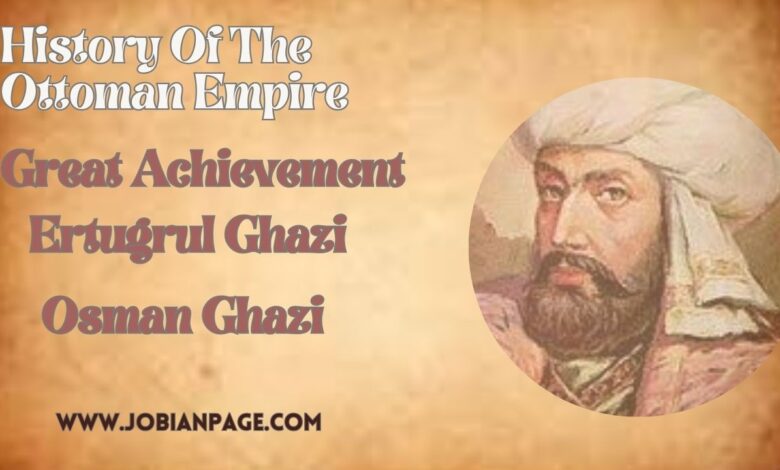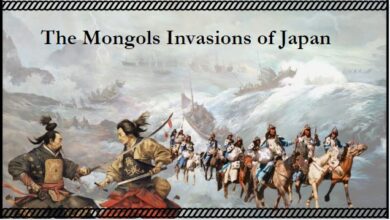History Of The Ottoman Empire

History Of The Ottoman Empire. At the time of the emergence of Islam in the Arab region, there was 2 non-Muslim empire at their peak. One was the Roman Empire and the other was the Persian Empire At that time, both superpowers never got to miss any possible chance to humiliate each other. Even they never considered Islam as much worthy, that it could be able to compete with them in this power game.
However, history witnessed that Islam not only destroyed the existence of these two superpowers but also emerged as the only superpower in that region. Similarly, when a weak branch of the Oghuz Turk tribes in Transoxania had to leave their homeland due to lack of food. No one knew that these helpless nomadic goat herders people would succeed in building such a strong empire /That will last for six hundred years to come and spread to three continents.
History Of The Ottoman Empire Sultans
The Ottoman Empire was not only spread over 3 continents but also has the distinction of being the longest-lasting empire on earth. It reminder the Muslims to their glorious past. Which was considered the caliphate and leadership of the Arab and non-Arab Muslims as well as the only Muslim superpower of its time Yes, we are talking about the Ottoman Empire, which was created by Turkish Muslims. How did this journey that started with deportation end with deportation?
How did successive Ottoman rulers make the empire great? And how the mistakes of later Ottoman rulers weakened the empire to such an extent that it could not survive?we will not only cover above questions but also provide you very rare and important information from Ottoman genealogy. After the emergence of Islam in the Arab region, Islam subjugated all the surrounding empires.
And Muslim rule was established over a large area of Asia. 30 years after the Khilafah Rashida, the monarchy began in these areas. First the Umayyad dynasty and then the Abbasid dynasty continued to lead the Muslims. But gradually these government also began to weaken. On the other hand, the Mongols were rapidly wiping out all the governments around Central Asia.
One of which was the Muslim empire of Khwarazm. Which stood on the remnants of the Seljuk Empire. The borders of the former Seljuk Empire included a large part of Anatolia, in addition to Khorasan, Iran, Syria, and Iraq. Despite the decline of the Central Seljuk Empire, many areas were still ruled by members of the Seljuk dynasty. Sultanate of Rum was the strongest and most stable govt of these Seljuk sub-governments.
Around Transoxania, when the massacre of Genghis Khan began to escalate the limits. Then Kayi Turk tribes decided to emigrate from their homeland under the leadership of their chief Suleiman Shah. First of all they reached the city of Mahan in Iran. But Kayi Leader Suleiman Shah wanted to take his tribe away from Genghis Khan Massacre to Anatolia, the homeland of vast pastures.
From Mahan, this Kai tribe took the road to the city of Akhlat in eastern Anatolia. Great cordial relations developed between Suleiman Shah and Seljuk Empire. Not only Kayi tribe got too much attention here but prominent position as well. The Kai tribe also repeatedly thwarted anti-Seljuk crusades, based in Georgia and the Anatolian region of Trabzon.
History Of Ertugrul Ghazi
According to available information, four sons were born to Suleiman Shah. Ertugrul Ghazi succeeded in making himself the next Kai leader due to his extra ordinary leadership qualities. Ertugrul was married to a Seljuk princess named Halima Khatun, due to which this gypsy tribe quickly gained significant importance in the Seljuk ruling circles.
After the death of Suleiman Shah, Ertugrul Ghazi migrated to western Anatolia with a large part of his tribe. It is said that during the migration, two forces were fighting with each other in a field in front of Ertugrul Ghazi at some place. Ertugrul began to support the retreating army as per his own understanding. Thus Ertugrul’s advance led to the victory of the retreating army.
When the battle ended, it was discovered that the faction that Ertugrul Ghazi had sided was the Muslim forces of Seljuk and the defeated army against them was the Christian Crusaders. The commander of the Seljuk Islamic Army praised Ertugrul & their forces on his timely advance. Now the Seljuk had a powerful ally in the form of Ertugrul and his tribe, who gave their full support in the fight against the Romans.
Ertugrul remained loyal to the Seljuk Empire in these areas all his life. In return for these services, the Seljuk Sultan Alauddin Keykubad appointed him as Amir or chief of the surrounding areas of Sogut and surrounding areas. Viewers, this is where the real journey to the Ottoman Empire begins. With the rise of Ertugrul as chief, all the Turkish tribes in the surrounding area came under his rule.
The loyalty of Ertugrul continued until his last days. But in his last days, the Sultanate of Rum was slowly moving towards its end in front of the Mongol invasions. The Mongols destroyed almost all the Muslim empires in the region one by one. Just as the Mongols were destroying the last stronghold of the Muslims (the Sultanate of Rome) which was also of great concern to Ertugrul.
Ertugrul and the intelligent peoples wanted to establish a great Muslim empire that could withstand the Mongol invasions According to some historians, after Ertugrul’s death in 1299, his mission was carried out by his son Usman I. As the Sultanate of Rome had almost ceased to exist during the reign of Usman I. Therefore, all the Seljuk lands in their possession were now owned by Usman.
Osman Ghazi
Osman Ghazi not only saved these areas from Mongol invasions but also continued his policy of advancing in Roman areas like his father. The territories under Usman rule were exactly on the borders of the Roman Empire and clashes with the Roman army were common in these border areas.
The Roman Empire was much larger than the territories under Usman occupation. But still, Usman did not allow the Byzantine Empire to dominate him. Usman wanted to turn his territories into a strong state but these territories were not wide enough to be called his sultan or king. However, he continued to rule these areas as Bay. According to Turkish historical sources, Usman Ghazi got married twice. One of them was Rabia Bala Khatun.
His son was Allauddin Pasha. While Osman’s other wife was Malhun Khatun and his son was Orhan Khan. With the exception of these two sons, information about the other sons and daughters of Usman Ghazi is either limited or unsure. It is not even possible to say with certainty which of Alauddin or Orhan was the eldest. However, in 1326, when Usman Ghazi was nearing the end of his life, Orhan Ghazi conquered Brusa, a very important Byzantine city.
Great Achievement
Which was a great achievement for this nascent state. Brusa’s victory was Usman Ghazi’s dream. So he bequeathed to his son Orhan to be buried in Brusa. Orhan Ghazi added Bursa to his hereditary territories, and for the first time he used his father name as name of their empire (Ottoman Empire). And declared himself as a first real sultan of the empire. While some historians considered him as the second Sultan of the empire.
Whatever the name of empire or first sultan, a newborn Ottoman Empire had just begun After the death of Usman Bay, there was no major dispute between the two brothers, Alauddin Pasha and Orhan Ghazi, over succession. Because Alauddin Pasha considered Orhan Ghazi more deserving and entitled to lead the Ottoman Empire.
In 1331, Sultan and Han conquered Iznik. In 1337 the sultans conquered Izmat. Thus the sultan quickly seized almost all the territory north of the Black Sea from the Byzantines.And extended the Ottoman frontier east to Ankara. Along with the Byzantine territories, Karasi turk state easily come to the domain of Orhan Ghazi. Sultan Orhan also established armies such as the Yani chari or Janissaries to maintain the tradition of fight against the Romans. While the Ottoman Empire was gaining strength in Anatolia,
History Of The Ottoman Empire Byzantine
The Byzantine Empire was becoming weaker due to internal civil war Soon Byzantine Empire not only built relationship with Ottomans through royal marriages, but also gave a few coastal forts in their European territories. the result of which was that soon Prince Selman Pasha, the son of the Sultan Orhan Gazi, was able to wrest important areas like Gallipoli from the Byzantines. In this way, Orhan Ghazi succeeded in extending the Ottoman Empire border into Europe in 1354.
History Sultan Orhan
History shows some 5 to 6 marriages of Sultan Orhan in which Nilufar Khatun, the mother of the next Sultan Murad I, and Theodora Daughter of the second Byzantine Emperor Kantakouzenos, are very prominent. Shortly after the Ottomans entered Europe, Sultan Suleiman Pasha died in 1358, followed by Sultan Orhan Ghazi in 1359 or 1362. After the death of Sultan Orhan there were two claimants to rule the Ottoman Empire, one was Murad I, while the other was Khalil (Son of the Byzantine princess Theodora).
In this game of throne, Prince Khalil was killed and the ownership of the Ottoman Empire went to Sultan Murad. Sultan Murad did his best to eliminate every possible threat to the Ottomans in Anatolia, especially the Emirate of Karamania. In addition, the sultan advanced into Europe and annexed the entire Thrace (Greece) to the Ottoman Empire.
After that, the important Edirne & Philippopolis cities of Byzantium were also conquered. In 1371, an Ottoman commander defeated a much larger united crusader army in a single battle. As a result of this war, the borders of the Ottoman Empire reached from southern Bulgaria to eastern Serbia, and some of the smaller states of the Balkan region also accepted the supremacy of the Ottomans. This battle is remembered in European history as the Battle of Maritsa.
History Of The Ottoman Empire Sultan Murad I
Along with this, Sultan Murad I extended the Ottoman borders in Anatolia to Tokat. Sultan Murad divided the Ottoman Empire into two parts administratively, in which the eastern side was named Anatolia and the western side was named Rumelia. During his 27 or 30 years reign, Sultan Murad increased the size of the Ottoman Empire five times. Sultan Murad expanded his father Orhan Ghazi’s empire from 20,000 square miles to 100,000 square miles.
Sultan Murad martyred at the Battle of Kosovo in 1389, but he appointed his son Bayezid as his successor in front of his commanders and government officials standing nearby. Thus, Sultan Bayezid became the next fourth ruler of the Ottoman Empire in 1389. First, Bayezid killed his brother Yaqub Chalpi and thus he became the next sole ruler to the Ottoman Empire. The biggest challenge for Sultan Bayezid was not to expand this vast empire, but only to manage it properly.
Soon after Sultan Bayezid gained firm control over the Ottoman Empire, he began his quest to conquer Bulgaria and in 1393 he conquered all of Bulgaria. he made several attempts to conquer Constantinople, but was unsuccessful. Sultan Bayezid also planned to conquer Italy, but in the meantime, Amir Timur attacked the Ottoman Empire from the east. Sultan Bayezid, now calling himself Sultan of Rome, suffered a crushing defeat at the hands of Amir Timur at the Battle of Ankara and lost all recognition as a European monarch.
History Of The Ottoman Empire Amir Timur
Amir Timur only wanted to weaken the Ottoman Empire, so he imprisoned the Sultan and created a situation of civil war between his princes. Timur returned/distributed all the seized ottoman land to Anatolian Turkic commanders. Sultan Bayezid could not bear the disintegration of the Ottoman Empire and died with this grief in 1403 during Timurid captivity. However, after a 10-year civil war, in 1413 AD,
Sultan Muhammad I succeeded in taking control of the Ottoman Empire. However, Sultan Muhammad’s entire reign was spent reforming the administration and suppressing rebellions, but Sultan Muhammad was able to reunify the Ottoman Empire. In 1421, Sultan Muhammad appointed his son Sultan Murad II as the next sixth ruler of the empire and died. Sultan Murad II also focused on keeping the Ottoman Empire strong and united, so he made a peace treaty of Szeged with the European Crusader powers.
History Of The Ottoman Empire Sultan Muhammad Al Faith
After satisfied with the internal affairs of the empire, In 1444, he handed over the Ottoman throne to his younger son, Prince Muhammad Al Faith. After doing this he retired. But only two years later they had to retake the Ottoman throne due to rising European powers. And in 1448 he once again fight and defeated European powers on the plains of Kosovo. After the death of Sultan Murad II in 1451 AD, Sultan Muhammad Fateh again ascended the Ottoman throne and did what no one expected.
In 1453, the Sultan conquered the city of Constantinople at the age of 21 and made it the new capital of the Ottoman Empire. During the reign of Sultan Muhammad Fatih, not only the Ottoman Empire regained its lost prestige, but it would be many times stronger and more stable than before. If you are interested to know the detailed Biography of Sultan Muhammad Fateh, then you can visit the above link.
History Of The Ottoman Empire Sultan Bayezid II
After the death of Sultan Muhammad Fatih in 1481, Sultan Bayezid II became the next ruler. who concentrated on saving his throne from his brother and failed to make any significant additions to the borders of the Ottoman Empire. But he became famous for one act in which he not only welcomed Muslims to his kingdom but also sheltered Jews in his kingdom after the fall of the Muslim kingdom of Granada in Spain.
Although giving shelter to the Jews was a good move, the Ottoman Empire later had to pay a heavy price for it. In 1512, his son Salim I usurped power from him. Sultan Selim I was a very strict Ottoman ruler. According to him, the only punishment for any negligence or treason was death, so all the dormant institutions of the empire became very active during his reign.
As a result, the Ottoman Empire not only ruled Anatolia, but also annexed Syria, Iraq, Iran, Hijaz-Maqdis, and the Mamluk Empire of Egypt to its control. Sultan Salim I also dismissed the Abbasid Caliphate, thus for the first time the title of Islamic Caliph passed from Arabs to non-Arabs (Turks). After the death of Sultan Selim I in 1520, his son Sultan Suleiman I took over the reins of the Ottoman Empire.
History Of The Ottoman Empire Sultan Suleiman I
Sultan Suleiman I is also remembered by historians as Suleiman the Magnificent because of his work for the rule of law and constitution in the Ottoman Empire. He gained great fame for his justice. When Sultan Suleiman’s reign began, the Ottoman Empire was at its peak, not only on the land but also on the seas. During this period, great sailors like Khairuddin Barbarossa were leading the navy of Sultan Suleiman Sultan Suleiman invaded Central Europe and conquered many strong fortresses and cities of Hungary.
Apart from that, the island of Rhodes, considered the center point crusader knights, was also conquered by Sultan Suleiman. For the first time in Ottoman history, the sultan rejected all Ottoman traditions and married one of his concubines, Hurrem Sultan who was a orthodox Christian. Later he accepted Islam.
However, it was Hurrem Sultan who emerged as a powerful queen in the Ottoman ruling circles. After Sultan Suleiman’s death in 1566, his son Sultan Suleiman II, who was the son of Hurrem Sultan, succeeded to the Ottoman throne. After the death of Sultan Salim II in 1574, his son Sultan Murad II succeeded him. Who started his rule by strangling his five younger brothers. When Sultan Murad III died in 1595. 19 of his sons were killed by order of his successor, Sultan Muhammad III.
Meanwhile, 19 funeral prayers were performed in a palace and every eye became tearful, after which this ritual was abolished. Now, imprisonment has been replaced by murder as an alternative solution. Muhammad III was the worst sultan in Ottoman history. He entrusted all government affairs to his mother. In 1603, Sultan Mehmed III was succeeded by his son Sultan Ahmed I,
Who assumed the Ottoman throne. During the reign of Sultan Ahmed I, a consort emerged as the most powerful Ottoman woman named Kösem Sultan As the infamous practice of killing all other claimants to the Ottoman throne was abolished after the death of Sultan Ahmed I, the rule of the Ottoman Empire passed to his brother Sultan Mustafa I in 1617.
But soon Sultan Ahmed I’s son Osman II rebelled against Sultan Mustafa I and ousted him from the Ottoman throne and became the new Sultan himself. 1618 The Ottoman Empire, which had recently participated in world geopolitics and played its role well, was now gripped by palace intrigues. After the death of Sultan Ahmed I, many princes claimed the throne of the Ottoman Empire, creating uncertainty among the ruling elite.
History Of The Ottoman Empire Sultan Mustafa I
At that time the sentiments of killing all other contenders for the throne felt necessary for the survival of the empire. However, some time later, Sultan Osman II was assassinated in a conspiracy and then in 1622, Sultan Mustafa ascended the Ottoman throne. In 1623, Sultan Mustafa I was once again deposed from the Ottoman throne and Sultan Murad IV (brother of Osman II) became the next sultan.
Since Sultan Murad IV was only eleven years old at the time, most of the decisions of the Ottoman Empire were made by Queen Kosem Sultan, who ruled and issue instruction behind the curtain. But even when Murad was able to manage the affairs of the kingdom, Kosem Sultan was still running the affairs and administration of the kingdom behind the scenes.
On the death of Murad IV in 1640, his brother Ibrahim succeeded to the Ottoman throne. Imprisonment left him almost mentally paralyzed and ill, making him an incompetent Sultan. Due to palace intrigues and turning against the Kosem Sultan: Kosem Sultan, with the help of the ruling elite, she placed Sultan Ibrahim’s six-year-old son Muhammad IV on the Ottoman throne in 1648 and killed his father (Sultan Ibrahim).
When Muhammad IV sat on the Ottoman throne, the ropes of this puppet Sultan were also in the hands of Kosem Sultan, who was disliked by the Sultan’s mother, so she killed Kosem Sultan through a conspiracy. This was the period when the decline of the Ottoman Empire had begun and the ruling circles of the empire were only focused on the machinations of the harem and the palace.
Meanwhile, the Ottoman Empire was losing badly on the diplomatic and political fronts and was gradually losing its control over the territories it occupied. For nearly the next two centuries, the Ottoman Empire was ruled by no notable sultans who played a significant role in world geopolitics or enhanced the status of the Ottoman Empire.
30th Ruler of the Ottoman Empire in 1808
Rather, most of the sultans who came during this period did not know anything about the affairs of the empire and the art of administration or you can say they were mostly token or puppet sultans. This was followed by the reign of Sultan Mahmud II, the 30th ruler of the Ottoman Empire in 1808. During his reign, for the first time, extensive administrative, military and financial reforms were carried out in the Ottoman Empire. The Sultan completely abolished the Janissaries (the Ottoman elite army unit).
He created a new, well-dressed, modern and European-style army with Turkish hats instead of turbans. These reforms had a profound political and social impact on the Ottoman Empire which eventually led to the birth of the modern Turkish Republic. After his father’s death in 1839, Sultan Abdul-Majid I assumed the Ottoman throne. Sultan Abdul-Majid I was a graduate of European schools and also proficient in French. His rule was the beginning of nationalist movements.
There is no doubt that during his period, the Ottoman Empire went on the path of modernization, but the empire of this modernization had to pay a heavy price. During the reign of Sultan Abdul Majid I, the Ottoman Empire had to take foreign loans for the first time in history during the Crimean War. In 1861, the ownership of Ottoman throne went to Sultan Abdulaziz.
Sultan Abdulaziz’s lavish lifestyle and grand construction projects led the Ottoman Empire to the border of bankruptcy by 1875, and it triggered rebellions throughout the Ottoman Empire. Sultan Abdul Aziz tried to make his son the heir to the throne, but Murad V, the son of Sultan Abdul Majid I, did not allow this plot to succeed and deposed him and became the next Sultan himself.
But due to the weakness physical and mental health his reign remained unstable Sultan Murad V was in favor of converting the Ottoman Empire monarchy into a constitutional government, but he was deposed after only 93 days in favor of his half-brother Abdul-Hamid II. Sultan Abdul Hamid succeeded his brother on the throne of the Ottoman Empire on 31 August 1876.
Now in Ottoman history, his period is known as the Hamidian Era. He came to the throne in a very difficult and critical period when the economic and political crisis was at its height and the existence of the empire was at stake due to the Balkan and the Russian wars, but he succeeded in establishing the writ of the Ottoman Empire. That is why he was a prominent figure in the Ottoman Sultan’s list.
Here we are going to tell you that you are watching the same Sultan character/role in the Turkish historical drama Payitaht: Abdülhamid It was Sultan Abdul-Hamid who promulgated the first Ottoman constitution in 1876, but despite his countless efforts, he could not stop the Ottoman decline.
The First World War
The Young Turk revolution that started in the Balkans eventually led to the fall of Sultan Abdul-Hamid’s rule. The Sultan was imprisoned and succeeded in 1909 by his brother Muhammad V as the next 35th ruler of the Ottoman Empire. The First World War began during the reign of Sultan Muhammad V. The Ottomans sided with Germany in this war and the Ottoman defeat in this war proved to be the last nail in the sinking ship of the Ottoman Empire.
All ottoman enemy forces aggressively attacked the Ottoman Empire. These anti-Ottoman forces not only divided the Ottoman Empire into parts, but the internal forces involved in the Young Turk Movement and Kemal Atatürk also played an active role in destroying the Islamic identity of the Ottoman Empire. Thus: The Ottoman Empire, which spanned three continents, was reduced to the Republic of Turkey, along with Anatolia and some European territories.
With the end of the caliphate, they not only confiscated all the assets of the remaining Ottoman rulers and caliphs, but also exiled them. Thus the journey that the ancestors of the Turks started in exile ended in exile because of their own people misdeeds. The remnants of the Ottoman royal family had to seek refuge in a Europe that had once recognized the sovereignty of their Ottoman ancestors.
These members of the Ottoman royal family have now spread all over the world and are known as Osmanoğlu , but the glorious history of this dynasty is now a legend of the past. This, my friends, was the story of the Ottoman dynasty, which tore out the heart of Christian Europe and planted a tiny sapling of Islam in it and nourished it with its own blood, which guided Muslims worldwide for six hundred years.






